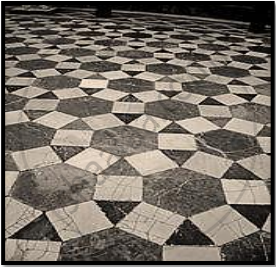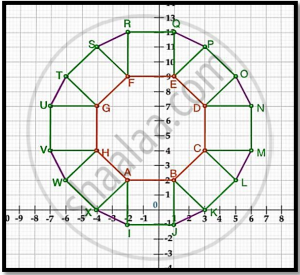Advertisements
Advertisements
प्रश्न
If A and B are (1, 4) and (5, 2) respectively, find the coordinates of P when AP/BP = 3/4.
उत्तर
The coordinates of the point dividing two points `(x_1,y_1)` and `(x_2,y_2)` in the ratio m:n is given as,
`(x,y) = (((lambdax_2 + x_1)/(lambda + 1))","((lambday_2 + y_1)/(lambda + 1)))` Where `lambda = m/n`
Here the two given points are A(1,4) and B(5,2). Let point P(x, y) divide the line joining ‘AB’ in the ratio 3:4
Substituting these values in the earlier mentioned formula we have,
`(x,y) = (((3/4(5) + (1))/(3/4 + 1))",((3/4(2) + (4))/(3/4 + 1)))`
`(x,y) = ((((15 + 4(1))/4)/((3 + 4)/4))","(((6 + 4(4))/4)/((3+4)/4)))`
`(x,y) = ((19/7)","(22/7))`
Thus the co-ordinates of the point which divides the given points in the required ratio are `(19/7 , 22/7)`
APPEARS IN
संबंधित प्रश्न
On which axis do the following points lie?
R(−4,0)
Two vertices of an isosceles triangle are (2, 0) and (2, 5). Find the third vertex if the length of the equal sides is 3.
If two opposite vertices of a square are (5, 4) and (1, −6), find the coordinates of its remaining two vertices.
Show that the points (−3, 2), (−5,−5), (2, −3) and (4, 4) are the vertices of a rhombus. Find the area of this rhombus.
In what ratio does the point C (4,5) divides the join of A (2,3) and B (7,8) ?
If R (x, y) is a point on the line segment joining the points P (a, b) and Q (b, a), then prove that x + y = a + b.
Find the value of a for which the area of the triangle formed by the points A(a, 2a), B(−2, 6) and C(3, 1) is 10 square units.
If the points A(−1, −4), B(b, c) and C(5, −1) are collinear and 2b + c = 4, find the values of b and c.
If the distance between points (x, 0) and (0, 3) is 5, what are the values of x?
If the centroid of the triangle formed by points P (a, b), Q(b, c) and R (c, a) is at the origin, what is the value of a + b + c?
Find the values of x for which the distance between the point P(2, −3), and Q (x, 5) is 10.
If A (2, 2), B (−4, −4) and C (5, −8) are the vertices of a triangle, than the length of the median through vertex C is
If points (t, 2t), (−2, 6) and (3, 1) are collinear, then t =
If points (a, 0), (0, b) and (1, 1) are collinear, then \[\frac{1}{a} + \frac{1}{b} =\]
If points A (5, p) B (1, 5), C (2, 1) and D (6, 2) form a square ABCD, then p =
If P(2, 4), Q(0, 3), R(3, 6) and S(5, y) are the vertices of a parallelogram PQRS, then the value of y is
The distance of the point P(2, 3) from the x-axis is ______.
The coordinates of two points are P(4, 5) and Q(–1, 6). Find the difference between their abscissas.
If the vertices of a parallelogram PQRS taken in order are P(3, 4), Q(–2, 3) and R(–3, –2), then the coordinates of its fourth vertex S are ______.
A tiling or tessellation of a flat surface is the covering of a plane using one or more geometric shapes, called tiles, with no overlaps and no gaps. Historically, tessellations were used in ancient Rome and in Islamic art. You may find tessellation patterns on floors, walls, paintings etc. Shown below is a tiled floor in the archaeological Museum of Seville, made using squares, triangles and hexagons.

A craftsman thought of making a floor pattern after being inspired by the above design. To ensure accuracy in his work, he made the pattern on the Cartesian plane. He used regular octagons, squares and triangles for his floor tessellation pattern

Use the above figure to answer the questions that follow:
- What is the length of the line segment joining points B and F?
- The centre ‘Z’ of the figure will be the point of intersection of the diagonals of quadrilateral WXOP. Then what are the coordinates of Z?
- What are the coordinates of the point on y-axis equidistant from A and G?
OR
What is the area of Trapezium AFGH?
